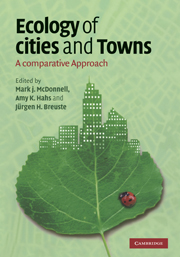Book contents
- Frontmatter
- Contents
- List of contributors
- Preface
- 1 Introduction: Scope of the book and need for developing a comparative approach to the ecological study of cities and towns
- Part I Opportunities and challenges of conducting comparative studies
- 2 Comparative urban ecology: challenges and possibilities
- 3 Frameworks for urban ecosystem studies: gradients, patch dynamics and the human ecosystem in the New York metropolitan area and Baltimore, USA
- 4 Comparative effects of urbanisation in marine and terrestrial habitats
- 5 Comparative ecology of cities and towns: past, present and future
- 6 Comparative urban ecological research in developing countries
- 7 Using models to compare the ecology of cities
- Part II Ecological studies of cities and towns
- Part III Integrating science with management and planning
- Part IV Comments and synthesis
- References
- Index
- Plate section
7 - Using models to compare the ecology of cities
Published online by Cambridge University Press: 04 March 2010
- Frontmatter
- Contents
- List of contributors
- Preface
- 1 Introduction: Scope of the book and need for developing a comparative approach to the ecological study of cities and towns
- Part I Opportunities and challenges of conducting comparative studies
- 2 Comparative urban ecology: challenges and possibilities
- 3 Frameworks for urban ecosystem studies: gradients, patch dynamics and the human ecosystem in the New York metropolitan area and Baltimore, USA
- 4 Comparative effects of urbanisation in marine and terrestrial habitats
- 5 Comparative ecology of cities and towns: past, present and future
- 6 Comparative urban ecological research in developing countries
- 7 Using models to compare the ecology of cities
- Part II Ecological studies of cities and towns
- Part III Integrating science with management and planning
- Part IV Comments and synthesis
- References
- Index
- Plate section
Summary
Introduction
Models are ubiquitous in ecology. By providing simplified representations of reality, models help ecologists to grapple with ecological systems that are inherently complex. From the theoretician who might construct models of the persistence of a species in patches through to a person collecting field data on a plant or animal, all ecologists think of ecological systems in the presence of incomplete information. Because our understanding of how ecological systems operate is based on a simplified representation of reality, all ecologists (in fact all people), whether they like to admit it or not, are modellers. The models may be written explicitly or simply contained within our minds; regardless, people make predictions using simplified versions of what they believe to be true, so all people construct and use models.
In this chapter, I will examine the role of models in ecology, and in particular how they can be used to compare the ecology of cities. I will briefly examine the range of models that are used in ecology, and argue that quantitative models are most useful for comparative ecology. I will then conclude by discussing some statistical issues associated with reporting analyses of quantitative models. But before I do this, I would first like to introduce you to mountain ash (Eucalyptus regnans) forests, an ecological system with which I am at least partly familiar, and one that I will use as an example throughout this chapter.
- Type
- Chapter
- Information
- Ecology of Cities and TownsA Comparative Approach, pp. 112 - 126Publisher: Cambridge University PressPrint publication year: 2009
- 1
- Cited by

